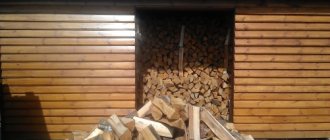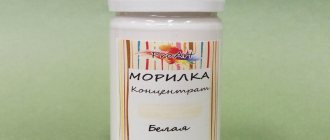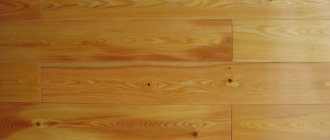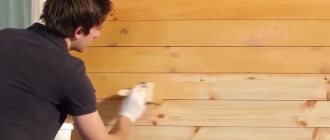Pine is a tree with its own characteristics. This is a coniferous plant, so it is necessary to take into account the presence of resins and other substances in it that tend to protrude from the wood, affect its absorption, interact in a special way with coloring agents and give other effects.
Pine is a tree with its own characteristics. This is a coniferous plant, so it is necessary to take into account the presence of resins and other substances in it that tend to protrude from the wood, affect its absorption, interact in a special way with coloring agents and give other effects.
Etching, wood tinting: getting the desired color
Etching and tinting of wood allows you to achieve a deep, uniform shade and emphasize the living texture of the wood. The RMNT website will tell you what dyes and stains need to be used to achieve a particular shade of wood. All recipes are old, time-tested.
There are two options for deep wood tinting:
- Hand dyeing with a plain cloth swab that will not leave fibers on the surface. The swab is moistened with mordant, the dye is applied to the wood;
- Soaking in mordant. According to experts, this is a more reliable way to get a color that will not be afraid of water and light. The wood is soaked in an enamel vessel of the required size; the wait will vary depending on the type of wood and the concentration of the solution. Then the wood is washed and dried slowly without access to natural light.
Wood is colored due to the fact that mordants react with tannins. The best types of wood to paint are oak, beech and chestnut - they have a lot of tannin. Birch and linden are slightly less susceptible to etching, and coniferous wood is the worst.
The process itself, as we see, is not too complicated. The main thing is to choose the right dye to get the desired shade. Let's list the old recipes:
- Black. In order for your piece of wood to become jet black or dark gray after pickling, you need to use iron, or rather, iron filings and acetic acid. By the way, the same color is given to wood by firing using the Japanese Shou-Sugi-Ban technology, to which the portal Rmnt.ru devoted a separate article;
- Orange, golden. This tone can be achieved by soaking ordinary poplar branches in water. Five to six days in such a solution in a bright room and the tree will have a noble golden color;
- Silver. All you need is rainwater and iron filings;
- Grey. You can get wood of this shade by soaking it together with willow bark;
- Wenge is a valuable tree. But ordinary potassium permanganate will help you achieve a similar shade. And at first glance, for example, beech will be indistinguishable from exotic wenge;
- Brown. Regular onion peels will help you get all shades of brown. With its help you can get a reddish tint. In addition, to dye wood brown, you can use walnut shells, coffee decoction with soda and apple tree bark;
- The blue color comes from oak sawdust and iron filings. To obtain a blue color, wood is soaked together with copper shavings;
- An interesting effect can be obtained using a natural dye such as wolfberry. With its help, adding other pigments, you can get blue, red, black, and brown shades;
- The yellow-green color will help to obtain an infusion of rhubarb root; hemp leaves will color the tree in a dark green hue.
As you can see, all the ingredients we have listed are natural, except for potassium permanganate and metal shavings. Experts in the field of wood etching often mix such natural mordants with chemical ingredients: copper, iron, zinc sulfate, 2% Epsom salt (magnesium sulfate heptahydrate), potassium chromium.
It is important to remember that the result of etching will depend on the type of wood! So, under the influence of Epsom salt, oak will turn brown, and birch will turn purple.
How to create different shades
To create the required shade, mixtures of different stains (dark and light) are applied to test samples. That is, if a darker shade is required, then a darker one is added to the light impregnation, and vice versa. Next, the mixture is applied to a test sample, which must be created strictly from the same batch of wood as the main material being processed. If this is a wall or other object, then you can select several areas and experiment on them, or take a risk and take similar wood, but keep in mind that the result may differ, since trees of the same species in our case may have significant differences in terms of their saturation with resins .
Impregnations for conifers of different shades can be mixed to achieve the desired tone. Another way to achieve the desired result is to add a special concentrator paint to the stain. Lightening can be accomplished by adding a colorless liquid to a darker one.
When purchasing, you should pay attention that there are different color options for stain on sale. In addition, there are a large number of paints for this substance. You can choose several individual color-changing concentrates or a set of them. Some retail outlets offer to create the required shade based on customer samples.
Brighter and brighter: tinting wood yourself
Antique wooden furniture always serves as interior decoration. But what if you want to update your decor a little? And I seem to be completely bored with the natural color of wood... Solid wood furniture tinting – a great way out! Doing tinting yourself is not that difficult. The main thing is to select the necessary materials and be extremely careful in the process.
No. 2 Paint filling method
This method works best on unsanded wood with a slightly rough surface (such as a wooden fence). With its help, wood can be given a rustic look and an antique effect.
Step by step:
- Clean the wood with soapy water and a brush and leave to dry.
- If your paint is too rich, thin it with thinner.
- After this, pour some paint onto the wood surface, and then take a scraper and spread the paint over the wood.
On an unsanded, that is, not completely flat, wooden surface, the paint layer will not be the same everywhere. A little more paint will flow along the depressions and less on the bulges, that is, in some places the white color will be more saturated, and in others more transparent, which will create the effect of antiquity.
You can see the result of painting a wall using this method above.
Selecting materials
Several types of coating are suitable for tinting wood yourself. Their choice depends on what result you want to achieve in the end. Here are the most common coloring compositions:
- Acrylic paint . You can buy it not only in construction stores. It saturates the surface well, but there is a significant drawback - when wood strongly absorbs the tinting composition, the fibers of its structure rise strongly. Therefore, it is better to mix acrylic with other substances for decoration. For example, with molding or glazing.
- Mordant . This is a dry pigment that is diluted with water before application. The big plus is that this dye does not saturate the surface, but simply clogs small particles of wood. Tinting with this composition will help to avoid unevenness and roughness of the structure. The mordant does not just color, it penetrates deep and acts chemically. This means that the brightness of the resulting colors is guaranteed! But after tinting the wood using this method, the array must be varnished. Otherwise, if moisture gets in, stains may remain on the furniture.
- Wood stain . The best option for tinting wood yourself. It does not lift fibers and does not require the application of an additional layer of varnish. You can also purchase patination - this is almost the same as stain, but its shades can be adjusted.
Rational use
It is best to choose a dye if you:
- Do you want to reveal the whimsical and original pattern of twisted wood, for example, maple or birch burl.
- You are working with dense types of wood that are poorly colored by pigment stain.
- You want to even out the tones of contrasting areas of wood, for example, the dark, sharp stripes of poplar or the sapwood of walnut.
- We decided to paint the surface in a bright color that is not typical of natural wood.
- You are tinting a tree that is prone to spotting caused by different densities of individual areas (pine).
Pigments will do an excellent job with such work as:
In some cases, to achieve the desired result, you will have to apply 2-3 layers of dye
- Enhancing the texture contrasts of wood with large pores.
- Preparing a surface that will be exposed to sunlight.
Important! Once you've completed your project and applied the finish, apply a coat of wax or wood paste wax over the stains for added protection and improved appearance.
Let's start tinting
There are several ways to tint. Paint by hand, spray or dip. The most common method that can be successfully used at home is painting with a brush. So, the old wooden bedside table is ready for its color transformation. And this is what she has to do:
- Cleaning and sanding . Before painting, it is important to level the surface and make the wood structure as smooth as possible. An ordinary sandpaper will help with this.
- Applying stain . Using a roller or brush, spread the paint evenly over the wood along the grain. And to remove excess, simply rub the stain with a dry cloth or swab.
- Paint drying . This stage is extremely important. It is better to be patient and wait until the layer dries thoroughly. Only in this case can you evaluate the final result of the work and the resulting shade. If it is not saturated enough, you can apply the stain again.
- Varnish coating . This completion of tinting prolongs the wear resistance of the colored wood product.
Do-it-yourself wood tinting is a rather labor-intensive process. However, if you love creativity and are not afraid to try new things, then this type of work will certainly bring maximum pleasure. And bright wooden interior items will delight you every day!
Still have questions?
Call or
Proper grinding
A step-by-step proven method on how to properly sand a pine board:
- to begin with, you can take coarse-grained discs for a grinder and, changing them in descending order, finish the procedure with disc No. 180;
- then, additionally sand it manually using a block with sandpaper No. 180. It is necessary to move along the fibers: this will remove marks from the sander;
- The final stage is sanding the ends with sandpaper with grit No. 220. This will prevent them from excessively absorbing the stain.
What is wood tinting oil?
The positive properties of wood are enormous: high strength, environmental friendliness, ideal heat-saving properties, natural decorativeness. But when exposed to natural conditions, wooden objects and construction wood used for external and internal work become deformed and rot. In addition, it is susceptible to mold, mildew, and damage by insects. However, all these negative nuances can be easily eliminated if you use oil tinting on wood. To protect wood (wood products) from getting wet, and to protect against negative influences such as rotting, mold, and fungus, impregnation is used - a special tinting oil for wood. Tinting oil is deeply absorbed, filling pores and fibers, strengthening the structure of the wood, which becomes moisture resistant and gains increased strength.
Operating principle of the oil
The principle of operation of tinting oil is impregnation of wood, deep absorption, filling all pores, in order to exclude access of insects, dust, moisture and dirt to the fibers, imparting strength, resistance to negative external influences and biological aging. Tinting oil applied to the surface of wood emphasizes the natural beauty wood and preserves its natural texture, creates a feeling of warm and natural wood, allows you to give the wood an original appearance and unexpected shades.
How to apply with a brush
It is advisable to use flat brushes: the wider the working part, the better - this will reduce the risk of layers of impregnation overlapping each other, which leads to uneven shade. Apply first along the length, then along the width, and then again along the length. That is, with cross-shaped movements. After 1 – 2 min. the remains are leveled with the same brush, but clean and dry - this additionally levels out the difference caused by the uneven absorption properties of the wood. A rich, even layer of impregnation left on the surface will provide a spectacular appearance to the treated surface.
What types of wood oils are there?
In modern domestic and foreign chemical industries, thanks to amazing developments, there is a wide range of types of wood oils, including: for interior use, for exterior use, for different types of wood, universal, with and without beeswax, for fire protection with the addition of special material. Made from natural resins and oils. Among the main and frequently used natural oils are sunflower, linseed, soybean, olive, jojoba, and pine tree resin. The palette of tinting oils for wood is varied and large, and therefore the oil not only completely protects the wood and extends its service life, but also gives it bright multi-colored shades to suit every taste, giving the product sophistication and beauty.
Properties and characteristics of tinting oil for wood
All tinting oils have very important properties when interacting with wood. Oiled wood:
- becomes less susceptible to wear, contamination, chipping, cracks and scratches;
- does not fade in the sun;
- does not respond to changes in temperature and air humidity;
- ideal for porous wood, since, penetrating deep into the pores of the wood, it does not clog them, while the wood “breathes”;
- non-toxic, harmless for impregnation in children's rooms;
- does not require pre-treatment of wood with soil;
- does not require constant dilution and stirring while working with it;
- does not have an unpleasant or pungent odor.
Oils for wood tinting are characterized by the fact that, regardless of their composition and area of application, they resist the formation of bacteria, are absorbed well and quickly, and increase the service life of treated products. And not only. There are special oils for wood, which are typical for wooden household items, various wooden and plywood shelves that interact with food. It is very important to buy a wood tint and treat high humidity areas on kitchen furniture, as it can prevent bacteria from molding on the wood.
How do tinted oils differ from each other?
Tinting oils differ from each other in composition, technology of application and purpose (for external or internal work), but they all serve mainly to protect wood from the destructive influence of the external environment and aggressive influences of various types.
Flaxseed oil is in particular demand among consumers, after tinting the surfaces acquire a beautiful silky, matte shine or a clear, natural shade of colored linseed oil, according to the color palette. Other characteristic features of linseed oil are better absorption than other oils and resistance to the development of bacteria. Linseed oil can be used as an independent decorative coating for both interior and exterior use. Impregnating wood with linseed oil improves the appearance of wood, increases the service life of products, and can be tinted perfectly to match any shade. Treated products are resistant to cracks, fading, and drying out.
Advantages of oils over other compounds
Wood has never gone out of fashion; it is rightfully considered the most popular material in construction, as the noble shades of valuable wood fill it with luxury and wealth. If previously wood was popular only due to the lack of other materials for construction, now we try to buy wooden materials for the main reason - environmental safety and durability. What should I use for processing (tinting) wooden structures, pieces of furniture, various products in the house, in the country, in the apartment, in the bathhouse, on the balcony, in the garage? With all the variety of materials for wood processing, in order to ensure a long and effective service life, it is worth choosing and buying the material that, according to its technical characteristics, is suitable for use for specific purposes. When choosing a material, you must consider:
- type of wood;
- operating conditions (humidity, air or room temperature);
- history of previous coatings, if any.
Stain, varnish, and oil are mainly used for tinting wood.
Liquid impregnation for wood, called stain, based on its production can be water, alcohol and oil. It is produced in the form of a ready-to-use solution and in powder form, allowing you to paint basically in the shades of any wood from the lightest to the darkest. Water-based stain has a significant drawback - it lifts the wood fibers, which makes the wood susceptible to moisture. Therefore, before applying stain, you need to wet the wood, let it sit for a while, and then saturate it with stain.
Alcohol-based stain dries very quickly - this is the main drawback, as a result of which stains form on the treated surface. Uniform coloring is obtained if the stain is applied from a spray gun.
Oil stain gives wood any color that can be obtained by mixing oil-soluble dyes, diluted with White Spirit solvent, dries quickly, does not lift fibers and is applied evenly. To achieve the desired color of wood, it must be coated in at least two layers, and each of these layers must be completely dry.
What does water-based varnish consist of?
Water-based varnish ingredients: water + binder + additives.
The varnish can be one-component , containing polyurethane or acrylic as a binder. There is two-component varnish in which both binders or some others are present.
water-based acrylic varnish It is not very durable; high humidity is contraindicated for it. Therefore, this varnish is used to coat products that are not subject to heavy loads. In any case, it’s definitely not worth covering the floors with it.
Polyurethane water-based varnish is reliable - it is used where significant loads are possible on the coating, it is not “eaten” by spilled alcohol or even stronger chemicals.
Water-based polyurethane varnish is highly durable
Two-component water-based varnishes are good because they show the positive aspects of all their ingredients, which complement each other.
Methods of applying oils
Treating wood with oil begins with preparing the surface.
- do not wipe the surface with a damp cloth (wood moisture content should not exceed 15%);
- Clean the wood from dirt and plaque and dry thoroughly.
- if work is carried out outdoors, then the weather should be sunny, and if indoors, then it should be dry.
Next, you can proceed in the two most commonly used ways: rubbing and soaking.
Rubbing consists of rubbing the wood 3-4 times along the grain with a cotton rag or any other lint-free cloth soaked in oil. You can also use a brush or applicator for rubbing, but in this case the oil consumption will be much higher.
When applying, constantly remove excess oil with a clean cloth.
We always make sure to maintain the consumption indicated by the manufacturer on the can.
After the 1st layer has dried, if necessary, cover the 2nd layer to obtain a darker color.
The second method, soaking, is used to treat small objects: crafts, knife handles and other objects. In this case, the product is completely immersed in oil for a certain time, then wiped and dried. The disadvantage of this method is the high consumption compared to the rubbing method.
What to consider when applying water-based varnish
- Water-based varnish should not be diluted with solvents. You can add water, but not more than 10-15%.
- Stirring the varnish before applying to the surface is mandatory.
- Varnishing, as well as drying of the coating, should take place with doors and windows closed to prevent drafts.
- Avoid direct sunlight on the fresh coating.
- To avoid sagging or bubbles, before applying the last, finishing layer of varnish, you need to go over the varnished surface with sandpaper.
- At first, it is better not to walk on already dried varnish in shoes with hard soles, but to place pieces of fabric or cardboard under the furniture - the water-based varnish gradually gains hardness and resistance to damage.
Advantages of ZAR tinting oil over other oils
ZAR oil products are in great demand among customers. The presented product has no analogues in the world. Always available for sale, used mainly for interior woodwork. When applying oil to horizontal surfaces, it is recommended to cover the top with ZAR polyurethane varnish, regardless of the base, or with tung oil. When using it outside, it is necessary to coat it with varnish for exterior use (ZAR Ultra Exterior).
The formula of linseed and tung oil allows them to be applied to vertical and horizontal surfaces.
The uniqueness of ZAR tinting oil for wood is that the consumption of this oil reaches up to 70 sq.m. per 1 quart (0.946 L) oil. Compared to oils from other manufacturers, this consumption is at least 2 times less.
The advantage of these oils is that they are oils that dry out quickly compared to other oils, such as soybean, hemp, and sunflower. A product coated with ZAR tinting oil, compared to other oils, does not fade over time during use and is not toxic. The UV filter in the formula of these oils prevents the wood from fading when exposed to sunlight.
The surface treated with ZAR tinting oil has a very high level of water resistance and durability. Another advantage of using ZAR oils is that it gives the wood a noble matte shade.
Gray maple.
In order to make a surface from any wood that is indistinguishable from gray maple , you need to immerse the wooden product in a solution of 50 grams of soap dissolved in 1 liter of clean water for 3-4 hours. Then the wood is washed with water, dried and placed for 1 hour in a 2% aqueous solution of iron nitrate Fe(NO3)3, washed again and dipped in a 2% soda solution. The last operation is keeping in an indigo carmine solution containing 12.5 g of this dye in 1 liter of water. As a result, the wooden product acquires a gray color with a bluish tint.
How can you give wood a brown tint? So, if oak or any other species (for more information about types of wood, see this section) with a significant content of tannins (for example, tannin) is soaked in lime milk (this is what is called a suspension of slaked lime in water), then after drying and removing the plaque lime with a soft brush, the surface of the wood will become light brown. And treating the surface of oak wood in a 20% solution of iron sulfate after drying will give a dark brown color, treatment with ammonia will give a gray-brown color.











